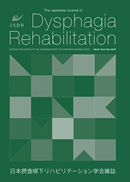Volume 1, Issue 1
The Japanese Journal of Dysphagia Rehabilitation
Displaying 1-12 of 12 articles from this issue
- |<
- <
- 1
- >
- >|
Review Article
-
1997Volume 1Issue 1 Pages 9-14
Published: December 20, 1997
Released on J-STAGE: May 16, 2019
Download PDF (2468K) -
1997Volume 1Issue 1 Pages 15-30
Published: December 20, 1997
Released on J-STAGE: May 16, 2019
Download PDF (6526K)
Original Paper
-
1997Volume 1Issue 1 Pages 33-44
Published: December 20, 1997
Released on J-STAGE: May 16, 2019
Download PDF (4903K) -
1997Volume 1Issue 1 Pages 45-56
Published: December 20, 1997
Released on J-STAGE: May 16, 2019
Download PDF (5333K) -
1997Volume 1Issue 1 Pages 57-68
Published: December 20, 1997
Released on J-STAGE: May 16, 2019
Download PDF (4726K)
Clinical Report
-
1997Volume 1Issue 1 Pages 69-73
Published: December 20, 1997
Released on J-STAGE: May 16, 2019
Download PDF (2092K) -
1997Volume 1Issue 1 Pages 74-80
Published: December 20, 1997
Released on J-STAGE: May 16, 2019
Download PDF (3051K) -
1997Volume 1Issue 1 Pages 81-88
Published: December 20, 1997
Released on J-STAGE: May 16, 2019
Download PDF (3798K) -
1997Volume 1Issue 1 Pages 89-93
Published: December 20, 1997
Released on J-STAGE: May 16, 2019
Download PDF (2121K) -
1997Volume 1Issue 1 Pages 94-100
Published: December 20, 1997
Released on J-STAGE: May 16, 2019
Download PDF (2836K) -
1997Volume 1Issue 1 Pages 101-103
Published: December 20, 1997
Released on J-STAGE: May 16, 2019
Download PDF (1123K)
Clinical Hint
-
1997Volume 1Issue 1 Pages 104-105
Published: December 20, 1997
Released on J-STAGE: May 16, 2019
Download PDF (1061K)
- |<
- <
- 1
- >
- >|
